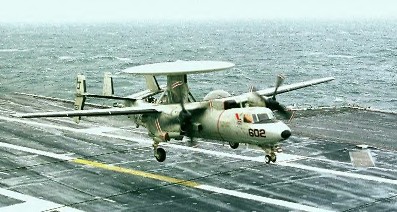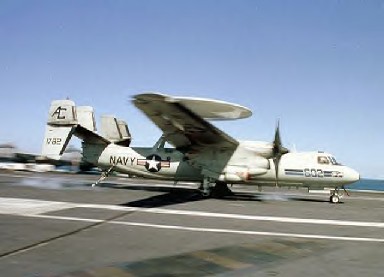The primary role of the E-2C Hawkeye aircraft supplied by Grumman is as an all-weather airborne early-warning aircraft to the naval task force. From an operating altitude above 25,000ft, the Hawkeye warns the naval task force of approaching air threats and provides threat identification and positional data to fighter aircraft such as F-14 Tomcats. Secondary roles include strike command and control, surveillance, guidance of search and rescue missions and as a relay to extend the range of communications.
The E-2C became operational in 1973. Block II aircraft, with improved engine and radar, entered service in 1992, with final delivery in 2001. As well as the United States Navy, E-2C aircraft are in service with the navies of Egypt, Israel, Japan, Singapore and Taiwan and, in 1998, the French Navy took delivery of two aircraft for the new Charles de Gaulle aircraft carrier. Deliveries have totalled more than 140 for the USN and more than 30 for other nations.
The aircraft is operated by a crew of five, with the pilot and co-pilot on the flight deck and the combat information centre officer, air control officer and radar operator stations located in the rear fuselage directly beneath the rotodome.
The fuselage is designed for carrier operations and is fitted with a nose-tow catapult attachment for accelerated carrier take-off, an A-frame arrester hook for engagement of the arresting gear and a tail bumper to withstand impact or scraping on the runway. For storage in the hangar, the wings fold hydraulically to lie flat to the fuselage. The fuselage is of light metal construction, and parts of the tailplane are of composite structure in order to reduce radar signature.
The large 24ft diameter circular antenna radome above the rear fuselage gives the E-2C its distinctive profile. The radome houses the AN/APA-171 antenna supplied by Randtron Systems, which rotates at 5 to 6rpm.
The Lockheed Martin AN/APS-145 radar is capable of tracking more than 2000 targets and controlling the interception of 40 hostile targets. One radar sweep covers 6 million cubic miles. The radarís total radiation aperture control antenna reduces sidelobes and is robust against electronic countermeasures. It is capable of detecting aircraft at ranges greater than 550km.
 In January 2002, the US navy awarded Grumman a contract for the E-2C Radar Modernization Program (RMP) to develop a new solid-state, electronically steered UHF radar.
In January 2002, the US navy awarded Grumman a contract for the E-2C Radar Modernization Program (RMP) to develop a new solid-state, electronically steered UHF radar.
The mission computer is equipped with an enhanced high-speed parallel processor. The Lockheed Martin AN/UYQ-70 advanced display system and computer peripherals provide the operators with multicolour displays, map overlays, zoom facilities and auxiliary data displays.
A global positioning system and a Grumman (formerly Litton) AN/ASN-92 CAINS (Carrier Aircraft Inertial Navigation System) are the main components of the aircraft's navigation suite. The aircraft is also equipped with the AN/ASN- 50 heading and attitude reference system, an AN/ARA-50 UHF automatic direction finder from Rockwell Collins, an AN/ASW-25B automatic carrier landing system and a Honeywell AN/APN-171(V) radar altimeter.
The communications suite includes an AN/ARC-158 UHF data link, an AN/ARQ-34 HF datalink and a Joint Tactical Information Distribution System (JTIDS) which provides secure voice and data communications.
The E-2C was originally fitted with two Allison T56-A-425 turboprop engines, but since the introduction of E-2C Group I variants, T56A-427 engines have been fitted. With the new engines, the E-2C can cruise on station for more than four hours, up to 200 miles from base.
Major upgrade programmes are continuing to the end of the service life in 2015. The first of the next generation standard, the Hawkeye 2000, was delivered in October 2001, with 21 on order for the USN, one aircraft destined for the French Navy under a foreign military sales (FMS) agreement and two for Taiwan. USN aircraft will achieve Initial Operating Capability (IOC) in 2004. Northrop Grumman is also to upgrade a number of USN aircraft to Hawkeye 2000 configuration. Egypt is to upgrade its five E-2C Hawkeye to Hawkeye 2000 standard and will receive one additional upgraded E-2C. The Japanese Air Self Defense Force is also upgrading its 13 Hawkeye aircraft.
Hawkeye 2000 features a Raytheon mission computer upgrade (MCU), Lockheed Martin Advanced Control Indicator Set (ACIS), co-operative engagement capability (CEC), satellite communications, new navigation and flight control systems. The MCU is based on open architecture commercial off-the-shelf (COTS) technology, with increased memory and faster processing. The CEC consists of processor, data distribution system and antenna and will enable Hawkeye 2000 to perform real-time battle management, fusing and distributing information from sources such as satellite and shipborne radar.
 Manufacturer: Grumman
Manufacturer: Grumman
Wingspan: 80 ft. 7 in. (24.56 m)
Width, wings folded: 29 ft. 4 in. (8.94 m)
Length overall: 57 ft. 8.75 in. (17.60 m)
Height overall: 18 ft. 3.75 in. (5.58 m)
Diameter of rotodome: 24 ft. (7.32 m)
Crew Members: 5
Powerplant: T56-A-427 Turboprop(2)
Power: 5100hp(each)
Max level speed: 338 knots (626 kph)
Max cruise speed: 325 knots (602 kph)
Cruise speed: 259 knots (480 km/hr.)
Approach speed: 103 knots (191 kph)
Service ceiling: 37,000 ft (11,278 m)
Min. takeoff distance: 1,850 ft (564 m)
Min. landing distance: 1,440 ft (439 m)
Ferry range: 1,541 nm (2,854 km)
Weight empty: 40,484 lb (18,364 kg)
Internal fuel 12,400 lb (5,624 kg)
